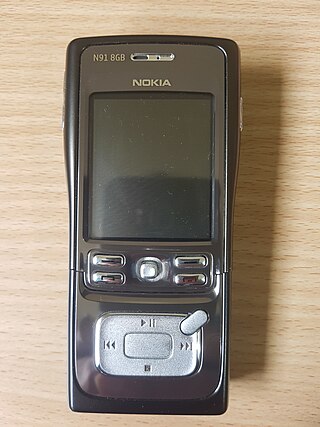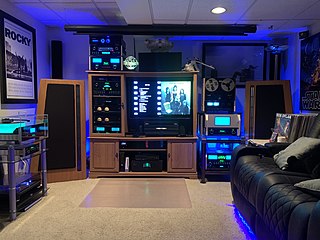
Vehicle audio is equipment installed in a car or other vehicle to provide in-car entertainment and information for the occupants. Until the 1950s, it consisted of a simple AM radio. Additions since then have included FM radio (1952), 8-track tape players, cassette players, record players, CD players, DVD players, Blu-ray players, navigation systems, Bluetooth telephone integration, and smartphone controllers like CarPlay and Android Auto. Once controlled from the dashboard with a few buttons, they can be controlled by steering wheel controls and voice commands.

A boombox is a transistorized portable music player featuring one or two cassette tape players/recorders and AM/FM radio, generally with a carrying handle. Beginning in the mid 1990s, a CD player was often included. Sound is delivered through an amplifier and two or more integrated loudspeakers. A boombox is a device typically capable of receiving radio stations and playing recorded music. Many models are also capable of recording onto cassette tapes from radio and other sources. In the 1990s, some boomboxes were available with MiniDisc recorders and players. Designed for portability, boomboxes can be powered by batteries as well as by line current. The boombox was introduced to the American market during the late 1970s. The desire for louder and heavier bass led to bigger and heavier boxes; by the 1980s, some boomboxes had reached the size of a suitcase. Some larger boomboxes even contained vertically mounted record turntables. Most boomboxes were battery-operated, leading to extremely heavy, bulky boxes.

HD Radio (HDR) is a trademark for an in-band on-channel (IBOC) digital radio broadcast technology. HD radio generally simulcasts an existing analog radio station in digital format with less noise and with additional text information. HD Radio is used primarily by AM and FM radio stations in the United States, U.S. Virgin Islands, Canada, Mexico and the Philippines, with a few implementations outside North America.

Lenoxx Electronics Corporation was an American distributor of electronic equipment. The brand appeared in the late 1980s as a transportable stereo (boombox) model.
Henry Kloss was a prominent American audio engineer and entrepreneur who helped advance high fidelity loudspeaker and radio receiver technology beginning in the 1950s. Kloss was an undergraduate student in physics at the Massachusetts Institute of Technology, but never received a degree. He was responsible for a number of innovations, including, in part, the acoustic suspension loudspeaker and the high fidelity cassette deck. In 2000, Kloss was one of the first inductees into the Consumer Electronics Association's Hall of Fame. He earned an Emmy Award for his development of a projection television system, the Advent VideoBeam 1000.

The Nokia N91 is a mobile phone produced by Nokia as part of their Nseries line of portable devices. It was announced on April 27, 2005 along with N70 and N90 as the first three Nseries devices. The N91 ran on Symbian-based S60 3rd Edition. It was the first ever phone encompassing a 4 GB internal hard drive, allowing storage for 3,000 songs. The N91 is highly focused on music,. with dedicated music keys on the front which slide down to reveal the keypad. It also featured the industry-standard 3.5 mm headphone jack, and was anticipated as a major challenger to Apple, whose iPod dominated the industry. The design of the N91 is based on stainless steel with a matte finish.
Roksan is a British manufacturer of high fidelity audio products for domestic use, based in Rayleigh, Essex. It is best known for its influential and innovative design for hi-fi equipment, and in particular its Xerxes platform for playing LP records.

A home theater in a box (HTIB) is an integrated home theater package which "bundles" together a combination DVD or Blu-ray player, a multi-channel amplifier, speaker wires, connection cables, a remote control, a set of five or more surround sound speakers and a low-frequency subwoofer cabinet. Manufacturers also have come out with the "soundbar", an all in one device to put underneath the television and that contains all the speakers in one unit.

An Internet radio device, also called network music player is a hardware device that is capable of receiving and playing streamed media from either Internet radio stations or a home network.

Cambridge SoundWorks was a Massachusetts-based consumer audio manufacturer and retailer.

The PAL or Portable Audio Laboratory is a radio produced by Tivoli Audio. It was designed by Henry Kloss (1929–2002). Supporting both the FM and AM bands, it was designed as an outdoor, portable version of the earlier Model One.

The Pepper Pad was a family of Linux-based mobile computers with Internet capability and which doubled as a handheld game console. They also served as a portable multimedia device. The devices used Bluetooth and Wi-Fi technologies for Internet connection. Pepper Pads are now obsolete, unsupported and the parent company has ceased operations.

The Nokia N800 Internet tablet is a wireless Internet appliance from Nokia, originally announced at the Las Vegas CES 2007 Summit in January 2007. N800 allows the user to browse the Internet and communicate using Wi-Fi networks or with mobile phone via Bluetooth. The N800 was developed as the successor to the Nokia 770. It includes FM and Internet radio, an RSS news reader, image viewer and a media player for audio and video files.

Wireless speakers are loudspeakers that receive audio signals using radio frequency (RF) waves rather than over audio cables. The two most popular RF frequencies that support audio transmission to wireless loudspeakers include a variation of WiFi IEEE 802.11, while others depend on Bluetooth to transmit audio data to the receiving speaker.
The Archos Generation 6 (Gen6) product series is represented by misc "Internet Media Tablets" or "IMT", e.g. the Archos 5 Internet Media Tablet This series of tablet computers developed by the French company Archos that features a resistive touchscreen for video, photo, audio, internet browsing and other multimedia applications. The individual numbering of the distinct models seems up to now to roughly resemble the length of the display diagonal in inches.

Home audio systems refer to audio consumer electronics designed for home entertainment, such as integrated systems like shelf stereos and music centers, as well as individual components like loudspeakers and surround sound receivers. The evolution of home audio began with Edison's phonograph, transitioning from monaural to stereophonic sound in the 1950s and 60s. The term "hi-fi" emerged, highlighting sound accuracy and minimal distortion. Audio equipment evolved from large wooden cabinets to compact units. The 1970s introduced enhancements like quadraphonic sound and technologies like Dolby Pro Logic. The 1970s and 1980s also saw the rise of component-based stereo systems. Cassette decks became a staple in the 1970s. Integrated systems, termed "music centers" gained popularity in the 1980s. Table systems and compact radio receivers emerged as entertainment devices, with some offering features like cassette players and CD functionalities. Audiophile systems prioritize high-quality music formats and specialized equipment like premium turntables, digital-to-analog converters, and other high-end devices, with some enthusiasts preferring the unique sound characteristics of vinyl records and vacuum tubes. Modern systems often emphasize home cinema applications to enhance the audio experience beyond standard TV speakers.
The ZiiSound, Inspire and Creative Wireless Speakers is a range of wireless speakers by Creative Technology, which utilizes Bluetooth technology and apt-X audio codec for high-quality wireless streaming of audio.
Weltron is an electronics manufacturer and retailer, based in Oxford, North Carolina. It was previously located in Durham, North Carolina.












